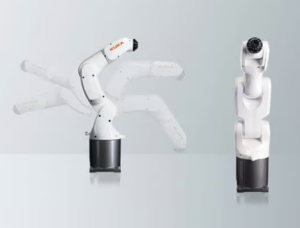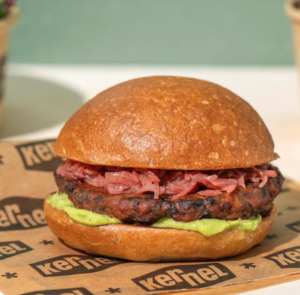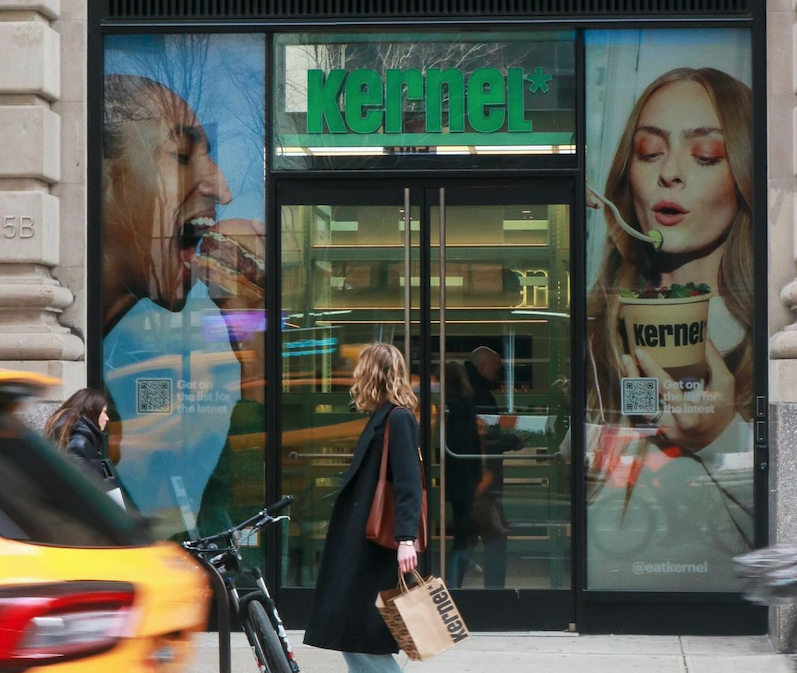Chipotle founder Steve Ells is out to fix the biggest pain points for restaurants while also saving the planet with his new concept Kernel, a robotics-run restaurant in New York City.
Kernel, which opened in mid-February for lunch only, uses modified off the shelf robotics and high-speed ovens to create an evolved quick-service restaurant that uses fewer staffers to execute its plant-based menu.
Ells plans to open about 15 Kernel restaurants over the next two years. But that amount of units won’t save the planet, he said. If he can prove Kernel’s operational efficiencies, he’s betting that food entrepreneurs will copy his business model in the same way the industry duplicated Chipotle.
“What if everyone copied this restaurant like they did the Chipotle model?” he said during a November “How I Built This” podcast. “When

Kernel Founder Steve Ells
people come in to look at the system, I think they will notice that there are fewer people working in the restaurant. They’ll notice the efficiencies. They’ll notice the reduced square footage. They’ll notice that it probably is a much lower investment than a typical restaurant. And so, people will be interested in copying or borrowing that model.”
Kernel’s hub-and-spoke model is geared for off-premises customers
Kernel uses a hub-and-spoke model to keep kitchen and labor costs down in the main restaurant.
Most restaurants have workers come in early to prep food before the store opens. That labor-intensive model is unnecessary at Kernel. Food prep is done off-site at a commissary dubbed the Kernel Central Kitchen.
Ells said in the podcast that experienced cooks prepare food every day in the commissary about five to 10 minutes from the restaurant.
“What’s exciting about this model is that you can really focus on the central kitchen doing prep all daylong,” he said, adding that fresh meals will be transported to Kernel “with a cadence of about a delivery every hour.”
As you enter the restaurant, there are stand-up counters where people can unpack and eat. But there’s no seating in the 1,200-square foot restaurant. All ordering is done through digital channels at the cashier-less restaurant.
Customers can order from the Eat Kernel app or website. QR codes in the restaurant direct customers to the restaurant’s ordering platform.
Stephen Goldstein, brand president, told Food On Demand in an email that Kernel’s small footprint is designed for urban environments where a “a large portion of traffic during peak hours is delivery and pickup with only a limited number of customers choosing to dine in.”
Goldstein said the model is ripe for replication — even in casual dining.
“Our model is a platform for making delicious food more efficiently, and we believe that it has a place across most categories, not just QSR and fast casual,” he said.
Robots do most of the work
Once the order is placed, robots prepare the meals.
Modified “off the shelf” automation equipment and robots cook the food, Ells said in the podcast. A customized robotic arm by Kuka places the plant-based patties in a special pan where they are cooked in an impingement oven, Ells said.
“The system knows what time it needs to start cooking the food. What time it needs to start toasting the buns,” Ells said during the podcast.
Once the food is cooked, humans come into play.

Kernel utilizes robotic arms by the company Kuka.
Employees assemble the meal, bag it for takeout, and place it in a cubby for pickup.
“Order fulfillment is a symbiotic relationship between the novel operating system, the robotic technology, and the three Kernel restaurant employees,” the company told Food On Demand.
Ells said Kernel has been testing its operations for a year now, so he expects the system to be “reliable” once the restaurant opens.
“This hyper-efficient, novel operating platform allows the Kernel team to make each meal to order, accurately and timed down to the second,” the company said. “Guests get exactly what they ordered precisely when they want it, and in doing that, Kernel is able to streamline food preparation and minimize food waste.”
Still, Ells said there’s always room for improvement, especially as robotics and AI get better.
“I expect we will open up and it will be highly reliable,” he said during the podcast. “I think that we will learn, though, as we observe it in the first few months. And you know, almost for sure, we will tweak it before the second restaurant opens.”
Kernel joins a fray of restaurants turning to back-of-the house robotics to streamline operations.
Chipotle is testing a robotic makeline by the California-startup Hyphen. The fresh-Mex chain, founded by Ells in 1993, and White Castle are also testing robotic fry cooks by Miso Robotics. Travis Kalanick, the founder of CloudKitchens, began testing kitchen robots in December through a partnership with Lab37.
Fewer employees earn higher wages
One of the most vexing problems Kernel aims to solve is restaurant labor woes.
“We see extraordinarily high turnover in the industry,” Ells said in the podcast. “I think it’s something like 165%. The folks are never there long enough to get really good at their jobs.”

Kernel employees bag meals for takeout, and place it in a cubby for pickup.
He said he expects Kernel’s turnover rates to be lower because the restaurant will be able to pay workers better wages and benefits because it has a smaller workforce. Kernel requires only three people to operate the restaurant. A typical fast food restaurant normally requires 12 employees.
At Kernel, two employees assemble and package meals for customers. A third employee is a “replenisher” who handles the food coming in from the central commissary to ensure the robotics-run kitchen equipment is fully stocked.
Smaller teams also mean managers can be better mentors to workers, whose responsibilities will be much more tech-focused.
“It’s different work,” Ells said on the podcast. “I mean, yes, it’s a restaurant, but there’s a lot of technology and understanding that technology and caring for that technology. Maintaining the technology. It’s a sort of an elevated position.”
As a result, he said Kernel’s workforce “will command higher wages.”
The starting wage at Kernel is $25 an hour. New York City’s current minimum wage is $16 an hour.
“With store employee enrichment central to its mission, Kernel is offering its employees compensation above industry norms, a comprehensive benefits package, and flexible schedules in addition to a stock option plan and ongoing seminars and education,” the company said.
Kernel’s plant-based menu helps reduce greenhouse gas emissions
Research shows that consumers who transition to plant-based diets help reduce greenhouse gas emissions, according to the National Center for Biotechnology Information.
But unlike other plant-based menu offerings found in fast-food restaurants, Kernel isn’t relying entirely on ultra-processed products like Beyond Meat and Impossible Foods for its menu.

Plant-based offerings include veggie burgers such as “The Kernel Burger”.
The menu, developed by a former Eleven Madison Park chef, features fresh salads and sandwiches made with ingredients such as roasted carrots, beets, cashews, quinoa, kale, farro, hummus, and lentils. The Kernel Burger, for example, is a roasted veggie patty made with sweet potatoes, quinoa, and chickpeas.
For its “crispy chicken” sandwich, Kernel is tapping Boston-based Motif. The startup’s wheat-and-soy patty is breaded, fried, and topped with thinly sliced dill pickles, chipotle mayo, and a vinegary slaw.
“I think people will eat more plant-based diets and make that part of their life if there are better options,” Ells said on the podcast. “And if we offer something that’s really compelling. Really delicious. Something you want to eat often. I think this could be a wildly successful business.”
So far, after a few weeks in operation for lunch only, “demand is high” for the menu, Goldstein said.
“We are feeling great – customers love the food and are enjoying the unique experience we offer at Kernel,” Goldstein said. “We have already seen a number of repeat visitors who cannot get enough of our signature veggies, sandwiches, salads and cookies.”
Nancy Luna is a contributing writer for Food On Demand. She can be reached at [email protected]


